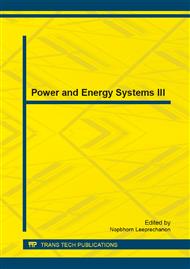p.482
p.489
p.493
p.499
p.503
p.507
p.511
p.515
p.519
Study on Frequency Characteristics of Valve in Heat Metering Control System
Abstract:
This paper has propose a new metering control system. From the control system, analysis the valve characteristics of heat metering control system. In the design of new heating metering control system, it is critical for electric valve closes when the appropriate degree of opening. Determine the adjustable range of indoor temperature,indoor the most at operating frequency, temperature and other indicators of the dynamic response time. In this paper, the mathematical model of the room heating calculation based on device characteristics through an example for solving typical temperature and time as a function of flow rate. The instantaneous heat dissipation radiator heat in the room, the electric valve to maintain the closed state. when the room temperature is not lower than the lower limit. By analysis the flow,when the coefficient is 0.59, the total cumulative time calories minimum number of the electric valve operations tends to 0, the system is the most efficient.
Info:
Periodical:
Pages:
503-506
Citation:
Online since:
January 2014
Authors:
Price:
Сopyright:
© 2014 Trans Tech Publications Ltd. All Rights Reserved
Share:
Citation:


